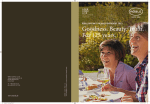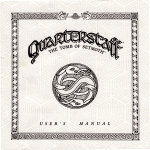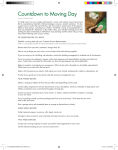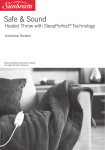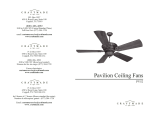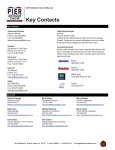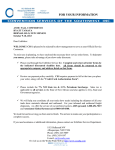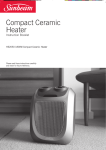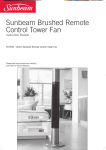Download Packing Tips from the Professionals at A Wise Move To Pack or Not
Transcript
Packing Tips from the Professionals at A Wise Move To Pack or Not to Pack. First decide if you want A Wise Move to do the packing for you, or if you want to save some money by doing all or some of the packing by yourself. Second, decide what you would want to take with you and what to leave behind. Consult the following tips to make your decisions easier: • Before you start packing, determine the items you want to throw away give away or sell. You will save money and have less to pack and unpack. This is the perfect time to unload unwanted items or call a local charity to remove items for you. And remember donating goods is a tax credit. • If you decide to do your own packing or partial packing, remember that A Wise Move is not liable for damage to boxes packed by the customer. For the safety of your items, tell the movers which boxes you packed. They are required to inspect each box prior to shipping. • You can save a lot of money if you do the bulk of the packing on your own. Limit yourself to non fragile items such as books, linens, clothing and shoes; and replaceable items such as plates, dishes (not fine china or expensive silverware), and small kitchen appliances. These items will be cheaper to replace in case of damage as opposed to hiring workers for the extra labor. Leave the furniture, mattresses, and heavy appliances to be packed by us. • Dresser drawers do not need to be empty. We can usually move chests of drawers with the contents of the drawers left intact. Do look through all drawers and remove any breakable articles for packing in boxes. Be sure that the contents of a drawer are not too heavy. Too much weight in the drawer could cause damage to the drawer while your furniture is in route. • Important items, such as photographs, wills, jewelry, home videos, and any other important documents, should be packed separately so that you can personally carry them with you on moving day. Another alternative you might want to consider is placing these belongings in a safety deposit box until after the move. Start Collecting Boxes Early If you decide to do your own packing, get packing supplies and start collecting strong boxes suitable for moving. Consult the following tips: • Look for boxes that have a uniform size, rather than just grabbing any old box you can get your hands on. The reasoning behind this is that such boxes are far easier to safely stack both in the truck and on a dolly. If the mover can take eight of these boxes out on a dolly in one trip and stack them all easily so they’re no risk of falling, it’s a win/win situation. • Get more boxes than you think you will need. Most people tend to underestimate the amount of boxes needed for their move. • It may be necessary to purchase from us some of the specialized cartons that will be impossible for you to find elsewhere. This would include such cartons as mattress cartons, wardrobe cartons, containers for large pictures and mirrors (telescoping boxes), and possibly some large size cartons for tall table lamps (lamp boxes). • Use towels and blankets to protect fragile items. Instead of just packing your towels, blankets, comforters, etc., use them to cushion delicate items like china and glassware. • An easy way to store cartons so that they won’t require a great deal of storage space is to open both ends of the cartons and flatten them out. You can open them again and re-seal the bottoms with your mover’s tape when you are ready to use them Start the Packing Process Early It always makes good sense to begin packing well ahead of the move. Most people have no idea how much energy and time packing requires. Complete all packing by moving day. You will be busy enough on moving day to have to worry about packing. You could start in areas where the goods are not in frequent use, such as the cellar, attics, garage, closet shelves, etc. Any items that you don’t need for your daily living routine should be packed first. There’s no reason older children shouldn’t do some of their own packing. It will make them feel a part of the process and save you some time and effort as well. Just keep an eye on how and what they’ve packed before the containers are sealed. Designate a room for the boxes and prepare adequate workspace. Consult the following tips to make your move more organized and quick: • You might consider setting up packing headquarters in a spare room, if available, so it’s ready to use when you can devote even a little time to the job. • Prepare a convenient place to work. The dining room table makes a good work surface. Be sure to cover it first with a heavy quilt or blanket. It’s handy, also, to have a covered card table on which you can line up the things to be packed. • Before starting the packing, separate your boxes by size, and place appropriate size boxes in each room. Have all supplies (i.e. tape, bubble wraps, packing paper) lined up next to your boxes when packing. • If possible, put packed and sealed boxes in one room. This will minimize the disruption you and your family feel as the packing process continues, as well as speeding up the loading process when the movers arrive. It is recommended to designate a room closer to the door. Remember to leave a clear path, in case certain items need to be put at the front of the truck. Pack on a room-by-room basis. Don’t get overwhelmed. Try to concentrate on one room at a time and do one area of the room at a time. Consult the following tips: • It’s best not to mix items from different rooms in one box. For example, don’t pack articles from the living room in boxes with articles from the kitchen. This will save much confusion later when its time to unpack. • Keep related boxes together so they will end up in the same room in your new home. This will cut the carrying time and make the move more efficient. • Don’t tape your boxes closed until you’re about to go, so you can add items as you see fit. • Put things in boxes with a view to where they’ll be in the new house, not where they were in the old one. • To prevent small items from being lost or mistakenly thrown out with the packing paper, wrap miniature knickknacks and other small items in brightly-colored tissue paper before placing them in the box. • Be sure that every box is clearly labeled by room and item. Labeling It is important to label each box carefully, with respect to the contents and its destination in the new home. Consult the following tips on how to label your boxes right: • For each room in your new home assign a name or number, for example, dining room – “1”, living room – “2”, kitchen – “3”, etc. Write the name or number on each side of each box, and make it big. Use a broad, felt-tipped marker. The reasons to use numbers instead of full text on the box are 1) if you have a lot of boxes it is much easier to write a number on each box instead of “Master bedroom”, especially when you are in a hurry, 2) you don’t want to attract too much attention to your boxes with tempting descriptions written on it. • To mark your boxes you can also use different colors for different rooms – as long as you plan the unloading carefully and mark the door of each room with appropriate colors (using colored balloons, for example). • It is important to have your name and new address written on each box, especially for long distance moves. It might be difficult to do given huge number of boxes you might have. But in case one of your boxes is lost in the process it would be much easier for the moving company to find and mail it to your new address. • To be more efficient, you can print the labels with your computer and tape them to your boxes. You can also ask your children write this information on the boxes so they can become familiar with their new address. • Use red marker to indicate “FRAGILE” on delicates, and “THIS END UP” where appropriate. Make sure those notes are clearly visible and written on each side of the box. • Make a master list of all household items and your belongings. Prepare for Arriving at Your Destination It may take some time to unpack everything when you get to your destination. It is important that you prepare for that when you plan your packing. Consult the following tips to make your unpacking more comfortable: • Prepare for the first night in your new home by packing essential items in a separate bag or box and carrying it with you. This bag or box should include: 1. Basic tools such as flashlights, pocket knife, hammer, screwdrivers, nails, masking tape, tape measure, and light bulbs. 2. Bathroom essentials such as hand towel, soap, toilet paper, shampoo, and shower curtains. 3. Personal items such as a change of clothes, toothbrushes, and prescription drugs. 4. Kitchen goods such as paper towels, coffee maker and filters, paper plates and cups, plastic utensils, dish detergent, a sponge, pet foods, dishes, can opener, and trash bags. • Keep an emergency medical kit available. Make sure any medication you are taking is packed in the emergency kit, along with any other over-the-counter medication you may need, such as aspirin. • When everything is packed and ready to load, make sure the items you need least are loaded first. General Packing Techniques Packing with good technique and the right materials can mean an easier move, but most importantly, proper packing can mean you avoid losing valuable items to breakage in transit. Packing techniques for heavy and light items: • Basic rule of thumb – pack light items in large boxes and heavy items in small boxes. The heavier the box the harder it will be to move. Pack no more than 50 pounds per carton. Don’t over-pack a container, even the small ones. Don’t make them so heavy they’re difficult to lift without straining. And always remember - lift the box with your legs, not your back. • When packing a box place large, heavy items on the bottom and lighter, more fragile items on the top. Group items of similar size and weight. Separate the items with bubble wrap or packing paper to prevent scratches caused by rubbing. •Pack boxes to the top. This prevents them from being crushed when they are stacked. Fill each box as much as possible using crumpled packing paper, bubble wrap, towels, pillows and blankets to fill empty space to prevent shifting and breakage. Make sure tops and sides of boxes do not bulge or sag. Under-packed boxes may collapse and over packed boxes may rupture. Packing Fragile Items • When packing small fragile items wrap each one individually with packing paper or bubble wrap. •Stuff boxes with fragile items with wads of paper, sheets, blankets, pillows and towels. This prevents shifting, rubbing, and possible breakage. Do not pack items too tightly, however when you shake the box the contents should not move. • The boxes with fragile items must be clearly labeled “FRAGILE”. Always stack them towards the top of your piles. How to Work with Moving Tape • When building a box start by taping the seam where the two flaps meet, leaving 1’ of overlap on each side. Add two more strips in the same direction, on both sides of your first strip, approximately half way between your strip and the edge of the box. For additional reinforcement, add two perpendicular strips equidistant from each other and the edge of the box. Use a tape dispenser to make the job easier. You can see how to do it right on the following chart: • Tape the top closed tightly when the boxes full. Run two strips of tape along the side and one strip down the center. If the box is still not strong enough, apply more tape to the sides. • Don’t apply tape directly to polished or painted wood finishes. Removing the tape could ruin the surface. Packing valuables and important documents You should personally pack and transport you valuables and important documents. Do-not-move items Some common household items cannot be included in your packed boxes because they are hazardous materials. Examples of these can be found in Packing Section- Items we don’t move. We cannot transport living things such as your plants or pets. Other important tips: • Plates, books and things of a similar shape, should be loaded vertically to utilize their own maximum structural strength. • To keep large items clean and sanitary, use mattress bags, furniture bags, and stretch wrap. • We will use moving blankets to wrap furniture, appliances, TV’s, or other large objects. • When disassembling furniture, beds, lamps, etc. put the hardware and bolts into a plastic bag along with any assembly tips and tape it onto the item itself. Packing Tips for Different Types of Household Goods Dishes, china, glasses and various kitchen appliances Packing is much more convenient, and less tiring when you have a good work area. It is suggested that you clear the kitchen table and do your packing on the table. • Before packing your dishes, make sure your boxes are prepared. Cushion the bottom, sides and corners of each carton with wadded packing paper, old linens or towels. Pack them in such a way so that they won’t bang against each other. Put plenty of Styrofoam or crunched up newspaper in the voids and cavities in the box when packing. You can also use dish/ glass dividers (also known as cell packs). • You will need plenty of packing paper for your dishes, glasses and other breakables. • Wrap each plate individually. Stack the wrapped plates in a bundle and rewrap the bundle with more paper. • When packing, never stack dishes flat. Pack dishes, saucers and platters on their edge. • Nestle your pots, pans, colanders. Cushion between each piece with packing paper. • Remove lids from jars and ceramics. Wrap each separately. • When packing your kitchen appliances like blenders and toasters, make sure they are clean. Cushion the bottom of the box. Use bubble wrap to pad the appliances all around and on top. Use medium sized carton, and mark it “Kitchen Appliances”. • Mark your boxes “Fragile - Dishware”, or “Fragile - Glassware” • When packing boxed food, such as cereals, seal with your plastic tape those boxes which have been opened. No need to wrap such items in packing paper. Note: If your shipment is going into storage then you should dispose of boxed foods. These items can attract rodents and insects. • When packing spices make sure all cans are closed and won’t leak. If in doubt, seal them with tape. Mirrors, artwork and lamps To pack mirrors, frames and pictures you will need: tape, blank newsprint, bubble wrap, Styrofoam peanuts, and flat boxes. When packing a mirror: • Place tape across the front of the mirror like an “X” to keep the pieces in place in case the glass breaks. • Wrap your mirror in bubble wrap or blank newsprint with cardboard taped around them. Fill loose spaces with lightly wadded paper. Mark the box “Fragile – Mirror”. When packing framed prints, paintings (with glass) or canvas: • Wrap your framed prints individually in blank newsprint, tape cardboard around them or wrap them with bubble wrap. • Cover a canvas with bubble wrap, and then tape it. • Paintings framed with glass should be taped across the front like an “X”. • Put your framed prints in flat fitted boxes. Fill in the spaces in the box with wadded paper in case the items fit loosely. • If you build a box for your painting, to get the right size make sure that it is slightly larger that the painting itself. • It is better if you pack your painting in 2 boxes, cushioned with bubble wrap in the space between boxes. Obviously, the second box should be larger that the first one. • When you are done with boxing your paintings do not forget to mark them “Fragile – Art”. • Small pictures can be wrapped with bubble wrap and boxed with other items. When packing a sculpture: • Wrap it carefully with bubble wrap. • Place it right in the center of the box. The box has to be at least one-third larger than the size of the sculpture with bubble wrap. It must not touch the sides of the box. Fill in all around the sculpture with Styrofoam peanuts. • When you are done with boxing your sculptures do not forget to mark them “Fragile – Sculpture”. When packing a lamp: • You will need large carton to pack your tall floor lamp. • Make sure you remove lamp shades and bulbs before packing your lamp. • You can put 2 or 3 lamp shades in one box, by nesting them. Protect from each other your lamp shades from each other by placing blank packing paper in between, do not use newspaper. • Remove the cord, if possible, or just wrap it around the base of the lamp. • Put some wadded-up packing paper on the bottom of the carton, to insure protection for your lamp. • Put several sheets of packing paper together and wrap your lamp with it. Use tape to prevent paper from coming apart. • Put your lamp in the center of the carton. Fill the empty space in the carton with wadded packing paper or with bubble wrap. • Do not pack anything together with your lamps and shades. • Don’t forget to mark your lamp carton “Fragile – Lamp”. Clothing: You can pack t-shirts and jeans in suitcases, garment bags and regular boxes but you shouldn’t pack your fine clothing in the same way. Hanging clothing such as suits, dresses and coats should be hung in wardrobe cartons. This will save you the trouble and expense of having your garments cleaned and pressed later. • You can leave some clothes in dresser drawers. If not, put your clothes from dressers into garment bags. • Use mothballs or similar products to protect your clothing from insects and other pests if going into storage. • Pack free space in your boxes with fragile items with clothes such as t-shirts. • Save space by tossing in shoes at the bottom of the wardrobe box. • Don’t forget to write “Clothes” on your wardrobe boxes. Books and CDs: If you’ve collected lots of books over time, it’s a great time to reevaluate what you really want to keep. Consider selling some at a yard sale or to a secondhand bookstore. • Pack your books in small boxes, so as they can be very heavy to lift when in a large box. Never pack more than 30 pounds of books in a box. • Fill in small spaces in each box with smaller paperbacks. Lay the books flat and alternate bindings to prevent damage and to keep stacks level in each box. • Record albums and CDs should be packed on end vertically, rather than placed flat and stacked. • Don’t forget to write “Books” or “CDs” on those boxes. Electronics: It is best to pack electronics in the original cartons. If you do not have one, use another carton box with the appropriate size. Wrap items in bubble wrap before putting it inside the box. When packing a computer: • Remember to have backup for all your files and programs. Put all your backup discs and floppy diskettes in safe container. • Use original or new boxes and foam forms to pack your computer. • Before packing your computer, first shut it down and ONLY then carefully unplug all the cables. • • Protect the screen of your monitor from it being scratched or cracked. Pack the monitor in its original box, or any other box of appropriate size, use Styrofoam peanuts or bubble wrap around the monitor. When packing CPU make sure that the motherboard is protected. Make sure that the system is packed upright or on its side – with motherboard side on the bottom –and that it is not being turned up and down during the move. When packing a TV or a VCR: • Make sure to disconnect your TV/VCR from the cable and cable box. Cable box and the cable belong to the cable company; therefore make sure not to pack it. • Unplug your TV/VCR and check if it cooled off before you start packing it. Note that it usually takes up to half an hour for the TV to cool off. • To pack your TV/VCR use foam forms to protect it on the ends, then slide it into the box. Mark your TV box as “Fragile – TV – Keep upright” and you are done. If the original box is not available, we will pack it for you. When packing stereo components: Make sure to mark all the cables and cords, so that you know where they should go when the items arrive to the new location. • Prior to packing your stereo components, check if they cooled off completely. • Original boxes are the best for packing your stereo components. However, if you do not have them, you can use two regular carton boxes instead, one a bit larger than another. Just take the smaller box, fill it with Styrofoam peanuts, and place the piece inside. Then place the smaller box in the larger one that is filled with peanuts on all sides. Close is, type it well and you are done. Large appliances Before packing any of your large appliances, you should look through the user manual. There might be some special instructions for packing them To prepare a washing machine for a move: •Drain all the water out of the washer and dry the interior thoroughly with a towel or sheets. •Take all accessories and fittings out of the machine, and put them in a separate bag. •Place towels or linens between the washing machine and the tub to prevent the tub from rotating. •Put towels or linens inside the machine. Tape the lid and the cord down securely. Finally, tie moving pads around the outside. To prepare a dryer for a move: •Disconnect the exhaust hose from the back of the dryer and from the exhaust duct in the wall. •Place the hose in the plastic bag or inside the dryer basket. •Put towels or linens inside the dryer. Carefully tape the lint screen, electrical cord, and dryer door down. To prepare a refrigerator or a freezer for a move: •Empty out the contents of your refrigerator and allow it to defrost. The doors should be left open several hours to air after defrosting. You should do it one or two days before the move. •Empty the drainage pan underneath and disconnect and drain out your automatic icemaker. •Clean the walls, drawers, and shelves with a disinfectant cleaner and dried well to prevent mildew. •Some refrigerators have "leveling rollers," which are wheels that raise and lower each corner of the refrigerator so it is even. Check your manual to see whether you should raise or lower them for the move. •Remove and wrap shelves (use bubble wrap if they are glass) and tape them together. Tape down all other loose parts, including the drawers on the inside and the electrical cord and doors on the outside. •Tie a large pad around it. To prepare a stove for a move: •Disconnect the stove prior to pickup. Make sure gas lines are shut tightly and capped. •Clean the oven and stove top. •Place all the oven racks on the bottom rung and tape them down. For electric ranges, removable coils and all other removable parts must be packed separately. •Tape down the burners and the protective pans under each burner. •Tape the electrical cord and door to the stove, lock the door, if you can, then tie a large pad around it. To prepare a dishwasher for a move: •Remove all dishes and tape down the racks and silverware basket. •Remove and drain the water hook-up. See your manual for instructions. •Close and lock the door. Tape the door shut. Tape the hose and cord to the dishwasher. •Tie a large pad around it. To prepare an air conditioner for a move: •If your air conditioner's in use, shut if off the day before so the coils can dry and cool off. •Remove and clean or replace the filter •Tape the cord to the side of the air conditioner (not the back, where the coils are). •Use the original box, if you have it, or another large appliance box well padded with wadded up newsprint. (Don't use Styrofoam peanuts, which could get inside the air conditioner and cause problems later.) •If you don't have a box, tie two large pads around it to protect the coils. Other items Clocks: Large clocks, such as grandfather clocks, often require special disassembly and possibly crating, which we will provide. With any clock, it is important to remove the pendulum. Pianos: It is best to leave it for our moving crew, they are able to handle the disassembly/reassembly of your piano or if a specialist should be hired to do this. Crating of this item is also recommended. Statuary, figurines, and curios: Wrap generously in bubble pack, wrap in a layer of clean paper and pack in boxes with plenty of crumpled paper or foam packing “peanuts” in between items. Objects with delicate appendages, such as candelabras or figurines with extended arms, should be wrapped with extra bubble pack and surrounded by extra packing material. Carpets and rugs: Carpets and rugs should be rolled up and tied securely with tape or rope. Bicycles: Bicycle handle bars should be loosened and turned sideways. To protect your other items from grease cover the chain and pedals with plastic. Tools: Check that tool boxes are closed and secure with tape or rope. Cover sharp tools with clothe or bubble wrap to prevent injuries. Power tools should be |packed| with plenty of cushioning. Gardening and other mechanical devices: All gasoline and oil must be drained from any tools or machinery that is to be transported. Batteries must also be disconnected. Do not put these items in boxes - wrap them in plastic or cloth tarps and secure with rope or heavy tape. Label each item after covering. Do not put boxes or other heavy items on top of your mechanical items. For specific instructions follow the tips in your owner’s manual or contact the original manufacturer if you no longer have the manual. Outdoor furniture: Disassemble it and place screws, nuts and bolts into a plastic bag. Tape the bag securely to the furniture. Unpacking tips When you finally reached your destination and you have a pile of boxes and furniture in front of you, it means you are almost done. All that is left to do is to unpack and put everything on its new place. Consult the following tips to make your unpacking a more pleasant experience: The kitchen: start unpacking from the kitchen. It is the best place to be set up first, because it gives your family a place to escape to from time to time for a break. Don’t unpack everything though, stick to the basics. You can leave less frequently used items in the boxes until you decide your room and storage arrangements. The bathroom: after kitchen move to unpack the bathroom. It is small, and shouldn’t take too long to finish. Make sure toiletries are unpacked and put in place, and the bathroom’s mechanical systems are functioning. Once the kitchen and the bathroom are unpacked you can safely proceed to the other rooms. The living room: before making any moves with your furniture, prepare a plan on a paper. Make sure you consider where cable and electrical outlets are located. Once you are satisfied with your planning, start moving the furniture, unpacking and hanging pictures and mirrors, and unpacking boxes. Bedrooms: don’t get stressed that you will not set up the bedrooms on the first day. Put mattresses and pillows in one room to go through the first night. Use help of your family members to reassemble the beds and place heavy furniture, but allow each bedroom dweller to unpack and arrange his/her personal belongings. Inventory: check your initial inventory to see if things are missing or broken. Any broken or damaged items should be kept on hand as a proof for any insurance claims. Breakables: unpack breakables over the box you’re taking them out of. That way, if you happen to drop an item, it will land on some packing material, thereby reducing its chance of breakage. Disposable items: it’s never too late to throw out those items that you haven’t used in forever. If you can’t find any place for them in your new home, get rid of them! Enjoy your new home!











